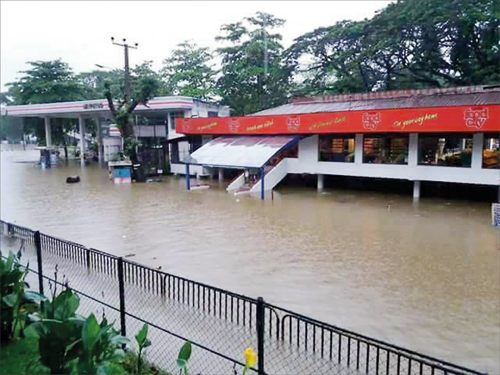Flood waters should be conserved for the country’s needs

Floods in Sri Lanka.
In Sri Lanka, over the past 20 or 30 years, we have experienced severe flooding each year due to the natural traces for flood water to disperse the water being blocked or used for other land use requirements including expressways construction. As a result, massive damage is caused to the built up area and the environment. At present, the situation is acute as there is flooding in the South and Central areas due to landslides, displacement of people, houses, equipment, physical infrastructure and for other reasons. The losses are estimated to be in billions of rupees depending on the rainfall annually. The irony is that while the South of Sri Lanka experiences flooding, at least 75 per cent of the flood water is allowed to flow into the Sea or is being pumped to the Sea. At the same time, in the North and East there is a frightful drought without water for the people. Therefore, the ideal solution is to have a mechanism of directing the excess flood water from the South to the North and East and vice versa.
Senior retired Irrigation Engineers are aware that during the British times, there was a proposal to dam the Kelani River and the water diverted to reservoirs both upstream and downstream at Kithulgala or thereabouts. This solution will prevent large volumes of flood water reaching Colombo District to flood the area and subsequently to be pumped to the sea. Similar solutions could be adapted for Kalu Ganga during the flooding. I am aware that detailed proposals were prepared by late Prof. A. Arumugam, late Eng. D.L.O. Mendis and others who have advocated this vision but unfortunately, no action was taken to implement this concept. The present irrigation engineers should have a commitment to embark on this challenge. The non-availability of financial resources may be a constraint but if the positives are greater, the government may be able to source a line of credit to implement this project. If so, water will be available for drinking, agricultural purposes, exports and for all Sri Lankans to lead a healthy life including the animals.
Alternatively, the Irrigation Department could identify ideal traces to direct the excess water through underground Hume pipes or similar in appropriate directions. These solutions may need modern technology and may also be expensive but in the long term, Sri Lanka would be the beneficiary as clean water could be given to all the population to facilitate good health. Many countries in Asia including Japan, Korea, Malaysia, Thailand and Singapore have flood water transfer or retention mechanisms. In Europe, some of the developed countries like Germany, France, Spain and Italy are already finding alternative methods for transferring water resources. The climate change has aggravated the situation.
In the Western Province as the floods are uncontrollable, large pumping stations are constructed at present to pump the flood water to the sea. If similar investments are made to pump the water to tanks at higher elevations or construct underground storage tanks as in several Asian countries at least some portion of the water being pumped to the sea and the water flowing to the sea could be reduced. As the population in the Western Province is projected to increase from 7 million in 2020 to 8.8 million in 2030 any water conserved would be of value (Railway Efficiency Improved Projects- Economic and Financial Analysis).
In 2016, according to the National Disaster Relief Services Centre (NDRSC), 24 out of the 25 districts countrywide were affected by flooding and landslides. In 2017, NDRSC recorded that due to the floods 23,000 houses were damaged, 70,000 acres of land destroyed, 213 dead, and 77 were missing. Consequently, the loss to the country was approximately Rs.117 billion.
Considering the financial and other losses annually due to floods, as a solution, the government should give priority to construct a network of water retention tanks to conserve the flood water in the Western Province. The long term solution for sustainability is to have a mechanism to direct the flood water to the North, East and other parts of the country where there is a scarcity of water.
(The writer is a veteran architect and town planner)
Hitad.lk has you covered with quality used or brand new cars for sale that are budget friendly yet reliable! Now is the time to sell your old ride for something more attractive to today's modern automotive market demands. Browse through our selection of affordable options now on Hitad.lk before deciding on what will work best for you!


